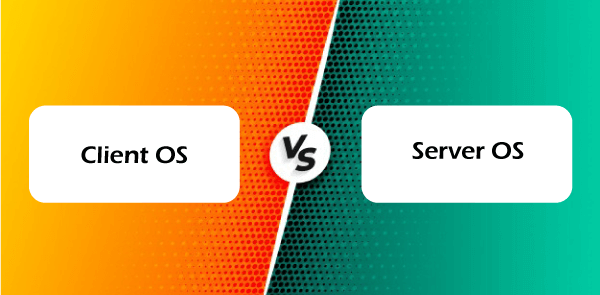Difference between Client Operating System and Server Operating System
The operating system acts as a bridge between the user and the hardware. The operating system performs various important tasks, such as memory management, process handling, files, controlling hardware devices, etc. It also ensures the safety of the system’s resources and data. There are several types of the operating system. Client operating systems and server operating systems are two of them.
In this article, you will learn the difference between the client and server operating systems. But before discussing the difference, you should know about the client and server operating system.
What is Client Operating System?
A client operating system is a computer OS that runs on desktop computers and other portable devices like laptops and smartphones. It may handle different hardware components connected to it, such as printers, monitors, and cameras.
These OSs support a single user at a time. A client operating system may use a server operating system to acquire services. Furthermore, when compared to server operating systems, client operating systems offer multiprocessing capacity at a low cost. Client OS includes Windows, Mac, Android, etc.
Features of Client Operating System
Various features of the client operating system are as follows:
- It provides support to a single user at a time.
- It runs on desktop systems and portable devices.
- Some client operating systems are Windows, Android, Mac, etc.
What is Server Operating System?
A server operating system is an OS that runs on a server. It is a more advanced version of an OS with more efficient features and capabilities for providing several services to other devices or client machines that are connected to it.
There are services for software, advanced hardware, and network configuration. These operating systems help install and use business and online web applications. They can also manage and monitor the client devices connected to them. The operating system commands initiate most processes in server operating systems. Furthermore, server OS carries out other administrative processes.
There are various OS server systems. Web server operating systems offer web resources like web pages according to the client’s requests. Similarly, server operating systems deliver services to client computers. Database server operating systems manage databases, whereas file server operating systems serve files to connected devices.
Features of Server Operating System
Various features of the server OS are as follows:
- It may access the server both in GUI and CLI.
- It controls and monitors client computers and operating systems.
- It installs and uses web applications and business applications.
- It helps to execute most processes from the OS commands.
- It offers a central interface for managing users, implementing security, and performing other administrative tasks.
Main Differences between Client and Server Operating System

Here, you will learn the main differences between the client and server operating systems. Various differences between client and server operating systems are as follows:
- A client OS is an OS that runs on desktop computers and other portable devices. In contrast, a server OS is an OS that is developed to be installed and utilized on a server.
- A client operating system may obtain services from a server. In contrast, a server operating system may offer services to many clients or end-user devices.
- One user may only use a client OS at a time. In contrast, a server operating system may serve several client devices simultaneously.
- A client OS may run on a client device, including tablets, desktops, mobile phones, and laptops. In contrast, a server operating system may run on a server.
- A server operating system is more advanced than a client OS and has more features.
- The client OS is less secure than the server OS. In contrast, the server OS is more secure than the client OS.
- Some examples of client operating systems are Windows, Android, Mac, etc. In contrast, some examples of server OSs are Mac OS X, Windows Server, Red Hat Enterprise Linux, etc.
Head-to-head comparison between the Client and Server Operating System
Here, you will learn the head-to-head comparison between the Client and Server Operating Systems. Some of the head-to-head comparisons of the client and server operating systems are as follows:
| Client OS | Server OS |
|---|---|
| It is an OS that runs on desktop computers and other portable devices. | It is an OS that is developed to be installed and utilized on a server. |
| It is a simple and easy OS. | It is a complex OS. |
| It provides less security than the server OS. | It provides more security than the client OS. |
| It may run on a client device, including mobile phones, desktops, tablets, and laptops. | It may run on a server. |
| It may get services from a server. | It may offer services to many clients or end-user devices. |
| It is less stable than the server OS. | It is more stable than client OS. |
| It is less efficient than server OS. | It is highly efficient than client OS. |
| Some examples of client OSs are Android, Windows, Mac, etc. | Some examples of server OSs are Mac OS X, Windows Server, Red Hat Enterprise Linux, etc. |
Conclusion
Client and server OS are two different types of operating systems. The client OS runs on end-user devices like PCs and other portable devices. In contrast, server OS runs on a specific device known as a server. Therefore, the client and server both operating systems differ.
